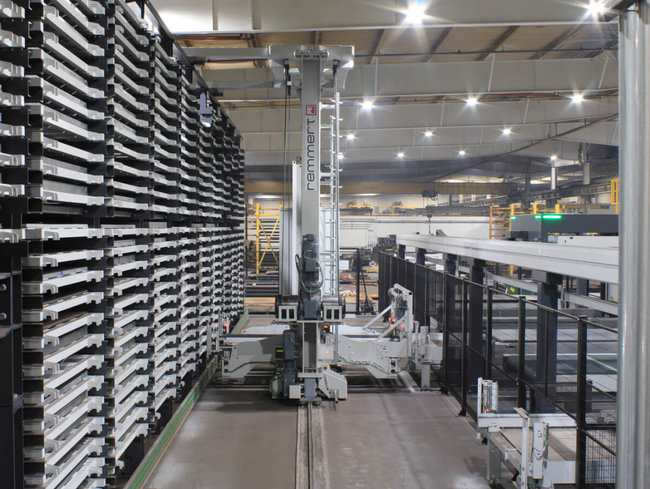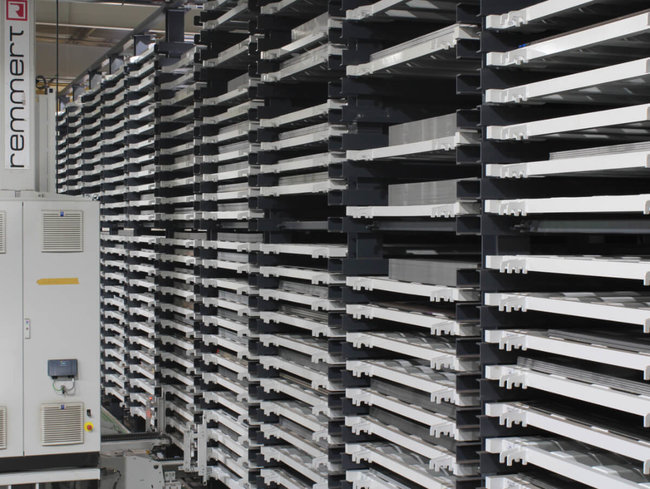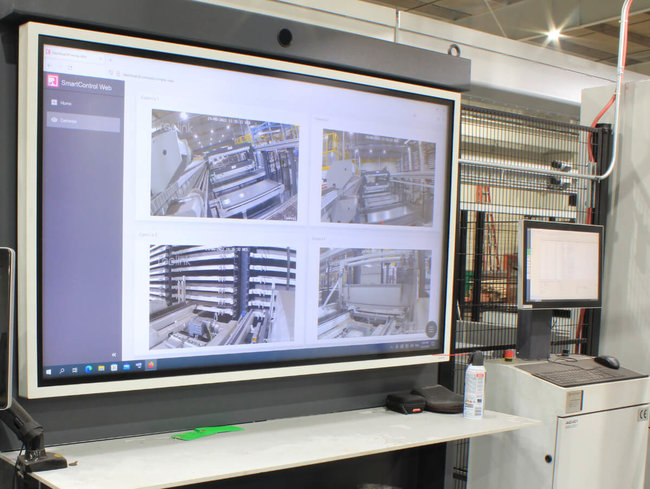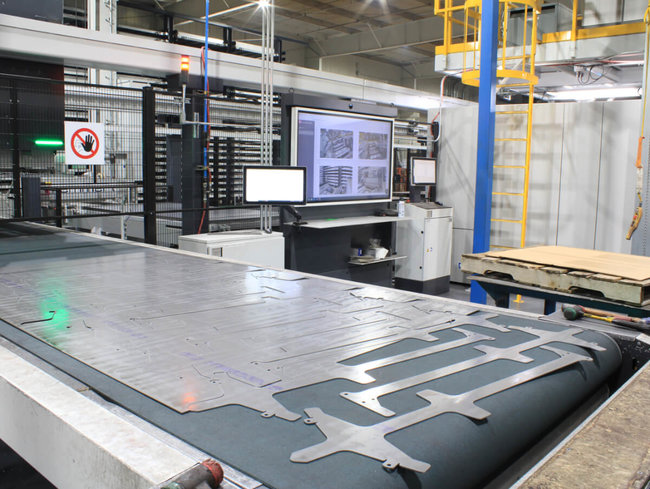Inefficient use of space at a metal fabrication business leads to inefficient production. The objective of Schuette Inc.’s Metal Division in Wausau, Wisconsin, was to maximize its steel storage and laser cutting capabilities. To help achieve that, the shop replaced three CO2 lasers with two Bystronic fiber lasers to gain additional capacity. It also purchased a MIDI System “L” large-format 3015 sheet metal storage system from Remmert GmbH in Löhne, Germany, says John Peterson, president of Schuette.
The two fiber lasers were integrated into a laser cutting center that is expandable up to four lasers, he adds. The center is in an area where the company stocked steel inefficiently. “And if we were going to expand that, it either meant continuing doing that or going with a vertical, linear-type storage system.”
In addition to reducing storage space by up to 60 percent, the sheet metal storage system provides fully automatic stocking of all formats, including special formats and semi-finished products, Remmert reports.
Peterson says Schuette expects to almost double its output with the automated system. With two lasers, the cutting center’s footprint measures 40 ft. by 100 ft., or 40,000 sq. ft., and can expand to 40 ft. by 200 ft., or 80,000 sq. ft., when four lasers are installed. The fabricator’s main manufacturing area has 120,000 sq. ft. and Schuette’s Central Wisconsin Finishing Division has a 100,000-sq.-ft. facility for E-coating (an immersion wet paint finishing process), powder coating, parts washing, shot blasting, bake-off and shipping.
The company’s current size and capabilities contrast sharply with its humble beginnings in 1972 as a regional fab shop launched by Peterson’s uncle, which employed about a dozen people. The Peterson family purchased the remaining company shares in 1983 and has since relocated and expanded several times and employs about 200 people. The company primarily serves the construction, agriculture and defense industries.
Starting The Search
Peterson’s quest for a better way to store steel began more than a decade ago when he investigated systems in Europe, including ones from Remmert. “Geographically, they don’t have as much land as we do,” he says of European manufacturers. As a result, they rely heavily on vertical storage. “They’re way ahead of us.
Major laser machine builders were using Remmert storage systems, Peterson says, noting that the way the system presents steel to the laser is more compact than alternative offerings, enabling the cutting center to have up to four lasers. “Whereas the other systems did not have that capability at the time that we purchased it.”
Longer term, Peterson says Schuett e plans to add two more fi ber lasers to double its throughput, as well as install an automated parts picking system that can handle the variety of part shapes and sizes the company produces. “When we have an automated parts picking system in that four-laser area, then all parts can be picked efficiently and effectively.”
Previously, Schuette had a two-tower storage system with 30 or 40 cassettes in it, Peterson says. The Remmert system has more than 130 cassettes, and each cassette can hold up to about 10,000 lbs. “It’s substantial.”
What’s also robust is the system’s construction, which Peterson says was appealing. “It’s German made and built like a brick outhouse.”
As Schuette strives to reduce part handling, Peterson says not having a robust storage system risks not being able to access workpieces as needed. “You will literally have your material in prison and that can really be devastating to an organization.” At Schuette, workpieces range from 20- to 30-gauge up to ¾-in. plate and a sheet can weigh up to about 1,000 lbs., he notes.
Materia In Motion
In operation, the main gantry system picks material stored in a cassette and then an automatic load-unit of LaserFlex 3015 that Remmert engineered and built transfers the single sheet and presents it on the laser table, Peterson explains. After the material is cut, an unload-unit of LaserFlex 3015 picks up the cut nest from the laser table and transfers it to an outlet conveyor.
“From a material handling standpoint, you never have to do a lot of heavy lifting. It takes a lot of the labor content out of the actual parts picking area,” Peterson says.
That labor reduction allows two people to operate the 6 kW and 15 kW fiber lasers without much difficulty, he says. As a result of the increased automation, Schuett e relocated four or five workers from the laser cutting area to other parts of the production floor.
As nearly all manufacturers know, attracting and hiring workers is a never-ending challenge. To help get students interested in manufacturing careers, Schuette works with local high schools and technical colleges to promote manufacturing, such as hosting a “heavy metal tour” to show students the company’s operation. In addition, Peterson says he is actively involved the Central Wisconsin Metal Manufacturers Alliance, which has more than 130 members. The alliance has initiatives with regional educational institutions and workforce development groups. The effort, which includes scholarships and even free training at local manufacturers, seems to be paying dividends.
“Our region of Wisconsin is really strong in manufacturing and is probably the biggest job creator in the state of Wisconsin,” Peterson says. Although the steel storage system and laser automation was built in Germany, Peterson says Remmert provides service to North American customers and has a 24/7 service hotline. Because Remmert is a medium-sized company, he adds that enables him to more easily reach and interact with key sales and service personnel compared to a larger organization.
“I have gotten to know of one the owners, Matt hias Remmert, very well. If we have to have anything resolved, he is literally one phone call away.” Remmert says, “For us, Schuett e is a perfect example of a future-oriented metal processor. By using modern warehouse and automation technology, increasing laser cutting by more than 100 percent is possible. Moreover, this is possible with the use of only a few modern machines and a significant reduction in personnel.”



